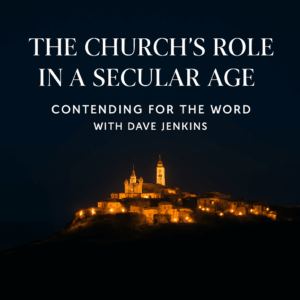⏱️ Estimated Reading Time: 4 min read
[et_pb_section bb_built=”1″][et_pb_row][et_pb_column type=”4_4″][et_pb_button _builder_version=”3.2″ button_text=”From Alpha to Omega: A Portrait of Jesus” button_url=”https://servantsofgrace.org/wp-content/uploads/2018/04/FromAlphatoOmegaAPortraitofJesus.pdf” url_new_window=”on” /][et_pb_text]
I saw the new Star Wars film recently. The last scene (slight spoiler warning) is a wordless image that summarizes the goal of all the action of the film and points ahead to the plots of the sequels. Many films are like that: After all the fights, misunderstandings, reconciliations, evil deeds, narrow escapes, heroism, foolishness, and wisdom, there is a quiet ending that sums it all up, often without words. I have always felt that the Lord’s Supper is like that.
In our worship service, the Supper comes at the end, before the benediction. We use some words to explain the sacrament, but for the most part, the sacrament is an image. The bread is broken and distributed to those who have received Jesus by faith. We eat together. Then we drink the cup as well.
Christ Proclaimed
When I introduce the sacrament, I usually connect it with the sermon. Our sermons, of course, range over the whole of Scripture. But it is never difficult to connect them to the Lord’s Supper, because the Lord’s Supper is the whole Bible in summary form.
In the Lord’s Supper, God gives us gifts of His good creation, which nourish our bodies, but broken they represent the death of the Son of God—the result of man’s fall into sin. But the image is not only death, but death as redemption — Jesus enduring death for sinners, for us who killed Him. And in the Supper, we also look to the future: As Paul says, we “proclaim the Lord’s death until he comes” (1st Corinthians 11:26).
This redemption is the whole meaning of the Bible. Whatever the preacher preaches on, if he’s preaching rightly, he’s preaching Christ (Luke 24:27). If he preaches God’s moral law, he’s preaching how the fall has injured us, why we need to turn to Christ in faith, and how the Lord wants His redeemed people to live. If the preacher speaks about Israel’s history, he’s telling us how God prepared the earth for the coming of Jesus and for His sacrifice for sin. When he preaches from the Book of Acts, he is telling us how God made His word to grow throughout the world, as believers set out to proclaim the Lord’s death “until he comes”.
What is true of the sermon is also true of the hymns and prayers in our worship service: they, too, drive into our hearts the gospel of God’s wonderful grace. God, who is perfectly holy, showed His amazing grace by sending His dear Son to give His life for us. We confess our sins, acknowledging that we have no hope of having eternal fellowship with God and one another, apart from what Jesus did for us. In our church we “greet one another” (Romans 16:16) after the confession of sin, confessing that the gospel is the very basis of our friendship and brotherhood. If someone is baptized, he is baptized into Christ, symbolizing our cleansing from sin through Jesus’s work.
All about Jesus
The Bible does not specify a single liturgy or order of events in worship that all churches must follow. My point, though, is that however we arrange the specifics, the service is all about Jesus and all about His sacrifice for us. So at the end we sum it all up with one humble, but glorious image: the bread and the cup—proclaiming the Lord’s death until He comes again.
[/et_pb_text][/et_pb_column][/et_pb_row][/et_pb_section]



